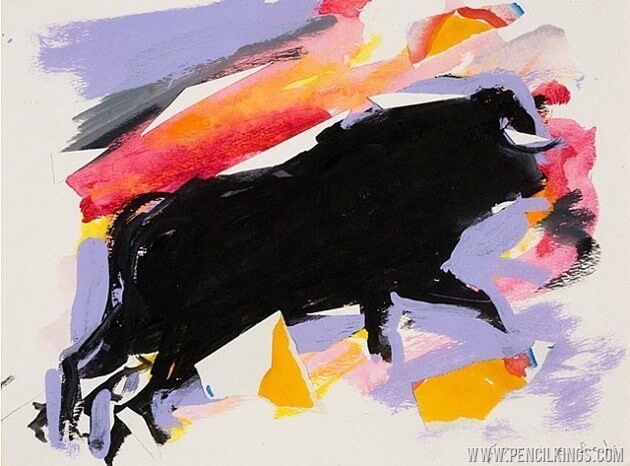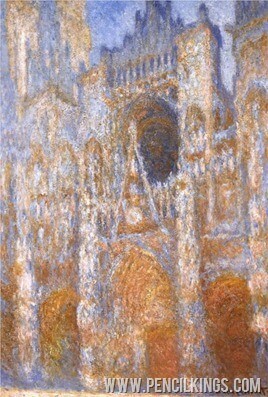
Bull by Elaine De Kooning – a great example of movement and energy in a painting
[one_whole]
Filling a sketchbook with vibrant ideas is one of the most important things an artist can do, but what happens when you try and work these movement drawings up into a finished piece of artwork? All too often, the end result is lacking something…and that something is energy!
So, how do you capture the action of your sketches in your finished paintings? How do learn how to draw and paint subjectively rather than objectively (like an architect or draftsman might do)? Let’s look at 5 easy ways to create subjective movement drawings full of life.
1. Don’t Worry About Getting Everything Right at First
When starting your sketch, try not to worry too much about getting everything exactly right. This is where doing some research beforehand can be really helpful. If you’re drawing people, a good understanding of human anatomy will enable you to get ideas down quickly without having to think too much about your subject. There are lots of books available on this subject, but we think Dynamic Anatomy by Burne Hogarth is one of the best. Don’t worry about taking everything in at first – just practice your drawing skills a little each day and you’ll soon see an improvement.
Try and think about the movement of your subject and draw lines to capture this. You need to try and depict the life of your subject (even if you’re sketching landscapes or buildings), so don’t be afraid to draw confident, sweeping lines to reflect this. You can add details and tweak the proportions of your drawing later. To see how important it is to capture a feeling of life in your movements drawings, try tracing a photograph. You’ll see the end result looks static and lifeless – even though you’ve copied something from life!
The Swiss sculptor, Alberto Giacometti (1901-1966), created some incredible life movement drawings in his career. Take a look at the marks he’s making to represent the life of his subject – it’s a fascinating study into using lines and how to depict a 3D object in 2D.

2. Use Markers or Paint to Draw Confident Lines
We’re all used to using pencils to sketch, but sometimes it can really help to ditch the graphite and make some more permanent marks instead. Why? Because using a marker or paint is much more decisive – it encourages you to draw more confidently and should help you lose that sense of preciousness you sometimes feel when you start a painting.
Start off by drawing something simple such as a small group of objects. The aim of this exercise is to get you thinking in a certain way and build up the confidence you need to draw shapes and add tonal values without thinking about it too much.
This method works with digital art too – try making some bold, confident strokes on the virtual canvas and, rather than hide the layer, use this to inform the rest of your painting.

3. Go Sketching on Location and Make Speed Paintings
A great technique for capturing the energy of buildings, landscapes or groups of people is to go speed painting or gesture drawing on location.
Leave your pencils at home – the name of the game here is to capture what you see before your eyes as quickly as possible.
Take a look at the Rouen Cathedral series of paintings by the famous French impressionist, Claude Monet.
In these masterpieces, considered by many to be the ultimate impressionist paintings, there’s an incredible sense of light and form as the sun shifts across the façade of this stunning example of Gothic architecture.
Why not have a go yourself? Choose a location and aim to paint it as many times as you can in a few hours. Try to spend no longer than around 15 minutes on each painting and see how the light changes. Doing this will encourage you to get ideas down quickly. Once you’ve finished, take a good look at your work – see how full of life your movement drawings and paintings now are?

4. Sketch People and Animals as Much as Possible
If it’s movement and life you want, what better than a trip to your local zoo? Not only will it be full of people moving about, you’re sure to see some animal action too! Sketching subjects like these is great practice, because you simply have to get your drawings down quickly to capture them. As with human anatomy, it can pay to do a little research on critters beforehand – Ellenberger’s book, An Atlas of Animal Anatomy for Artists, is a great place to start.
Again, don’t worry too much about getting everything right at first. The important thing is to use confident lines and marks in your movement drawings to capture the life of your subject – you’ll be able to refine things in more detail later.
Try keeping a sketchbook and a pen or pencil with you at all times – you never know when a great drawing opportunity will arise and it’s so much better than working from a photograph! Having said that, it’s also a good idea to take a picture for visual reference later – just in case you don’t have enough time to get everything down.

Shade and Darkness, The Evening of the Deluge, by William Turner
5. Capturing Energy in Your Finished Painting
So, you’ve been out speed painting and now have sketchbooks crammed full of useful ideas and movement drawings to develop into finished paintings. Trouble is, how do you capture the energy of these sketches in your big art project?
Take a look at this painting by the English Romantic artist, William Turner (1775-1851) – see how dramatic it is? It’s almost as if you can feel the rain on your face as the storm approaches!
The reason Turner was able to capture such an incredible atmosphere in his finished paintings was thanks to sketchbooks full of preliminary paintings and drawings. Many of these are just rough ideas – bold splashes of color and experiments with lights and darks – but they played a crucial role in his final paintings.
Perhaps you’ve heard the story about Turner being tied to the mast of a ship in a storm so he could observe nature to its full effect? Although some experts have concluded this story is probably a myth, it’s certainly true that this ground-breaking painter placed great value on speed painting and observation from life.
When working on your finished painting, use the information gathered in your movement drawings to inform the marks you make and the colors you use. Try and adopt the same free approach you had when out sketching and don’t worry too much about this being a finished piece.
Don’t be afraid to make mistakes – work confidently, work quickly and take a break from time to time tocheck you’re still capturing the energy of your speed painting sketches.
Learning not to be too precious about the end result can really help you as an artist. Have you recently tried speed painting or sketching on location for the first time? We’d love to hear from you, so feel free to leave a comment in the box below!
[/one_whole]
